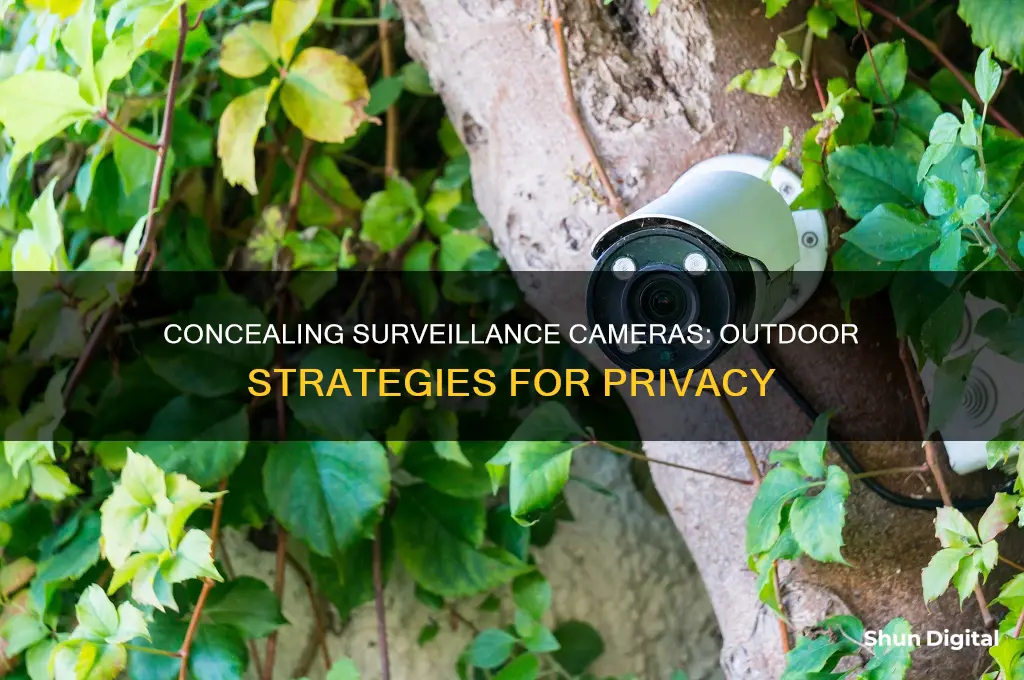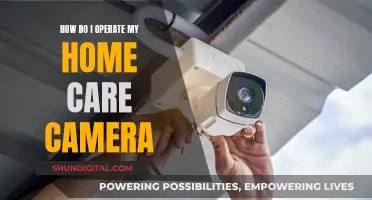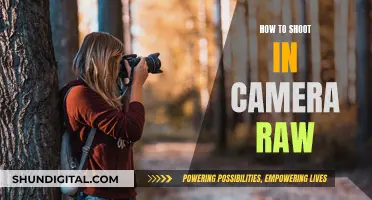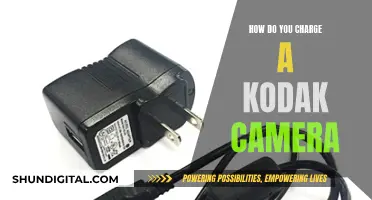
There are many reasons why someone may want to hide a surveillance camera outside. Visible cameras can be evaded by experienced thieves, who can also tamper with or steal them. A hidden camera can catch intruders in the act and, if wireless, can be placed in more discreet locations without unsightly wiring.
There are several ways to hide an outdoor security camera. One option is to camouflage it by painting it the same colour as the exterior wall or covering it with fake leaves and placing it near hanging plants. Another option is to disguise the camera by placing it inside or behind everyday objects such as a birdhouse, plant, fake rock, light fixture, or doorbell. Hiding a camera inside a mailbox or behind a glass window can also keep it out of sight. For wired cameras, PVC pipes can be used to conceal the wires.
When hiding a security camera, it is important to ensure the camera's view is not obstructed and that it is placed in an area with a strong Wi-Fi connection. It is also crucial to consider the legal implications and avoid placing cameras in areas where privacy is expected, such as bathrooms and bedrooms.
What You'll Learn
- Hide cameras in everyday objects like smoke detectors, clocks, or plants
- Mount cameras under eaves or gutters to keep them out of sight
- Disguise cameras as fake rocks, birdhouses, or lanterns
- Place cameras behind glass windows to protect them from tampering
- Use mini or wireless cameras for easier concealment

Hide cameras in everyday objects like smoke detectors, clocks, or plants
Hiding security cameras in everyday objects is a brilliant tactic to maintain surveillance without drawing attention. Here are some ideas for hiding spots:
Smoke Detectors
Smoke detectors are a great place to hide a security camera as they are often mounted high up on the ceiling, providing a full view of the room. Their placement in plain sight makes them an ideal disguise for a security camera, as they are unlikely to arouse suspicion.
Clocks
A wall or mantel clock can be a perfect host for a hidden camera. The camera can be embedded in the clock, disguised as part of its design. Just make sure the clock is positioned in a way that doesn't obstruct the camera's view.
Plants
A fake hanging potted plant can be an excellent cover for a hidden camera. The camera can be placed within the plant, disguised among the leaves. This method not only hides the camera effectively but also provides a natural and discreet look.
Other Objects
Other everyday objects that can be used to hide security cameras include picture frames, stuffed animals, tissue boxes, solar panels, and decorative items such as lanterns and bird cages. The key is to ensure that the camera blends seamlessly with its surroundings, making it difficult for anyone to suspect they're being watched.
General Tips
When choosing a security camera for your DIY hidden camera setup, opt for a miniature or wireless camera. These cameras are small, easy to conceal, and flexible in terms of placement. Additionally, consider the camera's features, such as high-definition video capabilities, motion detection, night vision, audio recording, and cloud storage.
Focus Camera LLC: Legit or Scam?
You may want to see also

Mount cameras under eaves or gutters to keep them out of sight
Mounting security cameras under the eaves of your roof is a great way to keep them hidden and protect them from the elements. Here are some tips to help you mount cameras under eaves or gutters:
- Choose the right camera: Select a small, wireless, and weatherproof camera that can be easily mounted under the eaves. Consider a mini or micro camera for better concealment.
- Plan the location: Identify the areas you want to monitor and choose an eave that provides a clear line of sight. Ensure the camera is mounted at an optimal height and angle to capture the desired field of view without any obstructions.
- Gather the necessary tools and materials: You will need a ladder, power drill, screwdriver set, measuring tape, level, mounting bracket, cable clips, screws, and other appropriate hardware.
- Install the mounting bracket: Mark the drill points on the eave, taking into account the camera's angle and desired coverage. Drill pilot holes and attach the mounting bracket securely, ensuring it is level and stable.
- Attach the camera: Position the camera on the mounting bracket, ensuring the camera's slots align with the bracket's configuration. Secure the camera with screws or fasteners, checking that it is firmly attached and stable.
- Manage cables: Use cable clips to neatly organise and secure the camera's cables along the eaves, hiding them from view. Ensure the cables are safely routed and protected from damage or interference.
- Test and adjust: Power on the camera and test its functionality, including image quality, night vision, and motion detection. Fine-tune the camera's angle and orientation to optimise its field of view and ensure comprehensive coverage of the intended areas.
By following these steps, you can effectively mount security cameras under eaves or gutters, keeping them discreet while maintaining optimal surveillance coverage.
Keep Your Camera On: Tips for Longer Battery Life
You may want to see also

Disguise cameras as fake rocks, birdhouses, or lanterns
One way to hide surveillance cameras outside is by disguising them as fake rocks, birdhouses, or lanterns. Here are some tips on how to do this effectively:
Fake Rocks
Fake rocks can be an excellent disguise for surveillance cameras as they blend seamlessly into a variety of outdoor environments, such as gardens or lawns. When choosing a fake rock camera, opt for one with a natural and realistic appearance to ensure it goes unnoticed. You can also consider models with features like motion activation, which starts recording when body heat is detected, and weatherproofing to withstand the elements.
Birdhouses
Birdhouses offer an ideal enclosure for surveillance cameras, with a small hole that accommodates the camera lens. This setup allows the camera to capture footage while remaining inconspicuous. When placing a camera in a birdhouse, ensure it is stable and that there are no obstructions blocking the camera's view. It is also essential to use a wireless camera to avoid the hassle of hiding wires.
Lanterns
Lanterns can be a creative way to disguise surveillance cameras, providing both lighting and security. Look for lanterns designed with built-in cameras or modify existing lanterns by carefully placing the camera inside, ensuring it captures the desired field of view. Consider using wireless or battery-powered cameras for easier installation and maintenance.
When disguising surveillance cameras as fake rocks, birdhouses, or lanterns, it is crucial to select items that blend seamlessly into their surroundings. Ensure that the camera placement is well-concealed and consider using camouflage skins or painting the camera to match its environment. Additionally, always be mindful of legal and ethical considerations when installing hidden cameras, especially in indoor spaces.
History of the Woca 120 GF Camera: When Was It Made?
You may want to see also

Place cameras behind glass windows to protect them from tampering
Placing security cameras behind glass windows is a great way to protect them from tampering. This setup has several advantages and disadvantages that you should consider.
Advantages
- Protection from Tampering: Cameras placed behind glass windows are harder to tamper with or disable than those in the open. Even if a burglar spots the camera, it will take them time to break the glass and disable the camera, giving the camera enough time to send footage and images to your devices.
- Deter Crime: Visible security cameras can deter crime. By placing a camera behind a glass window, you make it visible enough to deter potential intruders but also protect it from being tampered with.
- No Need to Hide Wires: Wired cameras placed behind glass windows don't require you to hide their wires, as the wires can be easily routed through the window frame.
Disadvantages
- Image Quality: Using a camera behind a glass window can affect image quality due to window glare or glass reflection, especially at night with infrared LEDs. This issue can be mitigated by turning off IR lights and using external motion-activated lights.
- Motion Detection: Motion detection may not work reliably through glass, especially with PIR motion sensors, as insulated glass limits heat transfer, which is necessary for PIR sensors.
Tips for Placement
- Get Close to the Glass: Bring the camera lens as close as possible to the glass to reduce window glare and reflection.
- Use a Suction Cup Mount: Consider using a suction cup mount that sticks to the window, with a magnetic screw mount to attach to outdoor cameras.
- Alternative Spots: If possible, find an alternative spot to install the camera outdoors, such as a soffit, overhang, ledge, or exterior wall.
- Keep the Window Open: If you're using an infrared wireless security camera, try leaving the window open slightly to reduce the glass reflection.
- Darken the Room: Ensure the room the camera is in is darker than the outside at night to reduce glare and improve image quality.
- Clean the Glass: Keep the glass panels or window glasses clean to enhance image quality and ensure the camera captures more details.
- Place Out of Reach: Install the camera out of reach so that it cannot be easily snatched or tampered with.
Unlock Halo Reach Theater's Free Camera Mode
You may want to see also

Use mini or wireless cameras for easier concealment
If you're looking to conceal your surveillance cameras outside, opting for mini or wireless cameras can make the process much easier. Here are some tips to help you get started:
Choose a Small Camera
The smaller the camera, the easier it will be to hide. Look for compact models that can be discreetly placed in various locations. Some recommended small-sized cameras include the Netgear Arlo Pro, LG Smart Security Wireless Camera, and Nest Cam IQ.
Go Wireless
Wireless cameras are ideal for concealment as they eliminate the need to hide wires. They are typically more expensive than wired cameras, but their ease of installation and flexibility make them a worthwhile investment. Popular brands of wireless security cameras include the Netgear Arlo Q, Belkin Netcam HD+, and Amazon Cloud Cam.
Battery-Powered Cameras
Consider choosing a camera that is battery-operated. This provides more flexibility in placement as you're not restricted by the need for a constant power source. Many battery-operated cameras also have long-lasting batteries, with some models offering up to six months of battery life.
Cloud Storage
It is recommended to choose a camera that automatically uploads footage to cloud storage. This ensures that even if the camera is tampered with or destroyed, you won't lose important video evidence. Look for brands like D-Link, Logitech, and Netgear, which offer cameras with cloud storage capabilities.
Creative Concealment
Once you've selected a mini or wireless camera, you can get creative with how you hide it. Here are some ideas:
- Birdhouse or bird feeder: Place the camera inside a birdhouse or feeder, pointing the lens out of the small opening.
- Bushes or trees: Thick foliage can provide natural camouflage for your camera. Just ensure that the lens isn't obscured by leaves or branches.
- Fake rock or garden gnome: You can purchase a hollowed-out garden decoration and drill a hole for the camera lens to peek through.
- Light fixture or doorbell: Some cameras are designed to look like light fixtures or doorbells, allowing them to blend in with their surroundings.
- Mailbox: Drill a hole in your mailbox and place the camera inside to record what's happening outside.
- PVC pipe: If you have a wired camera, use PVC pipe to conceal the wires and make them less obvious.
Remember, when placing your cameras, it's a good idea to combine hidden cameras with visible ones. This way, you can deter potential intruders while also having backup cameras in case the visible ones are tampered with.
Polaroid Camera Focus: Infinity and Beyond?
You may want to see also
Frequently asked questions
Good spots to hide an outdoor security camera include inside a birdhouse or bird feeder, in a bush or tree, inside a fake rock or garden gnome, or behind a glass window. You can also paint the camera to match the colour of your house or disguise it as a light fixture or doorbell.
Before hiding a security camera, ensure there are no obstructions blocking the view. If using a wireless camera, be mindful of its battery life and keep it within network range for optimal performance. Choose a camera colour that blends with its surroundings, and respect people's privacy by avoiding private areas like bedrooms and bathrooms.
Hidden security cameras are less likely to be spotted and tampered with by intruders. They can also help maintain the aesthetics of your home and provide a more accurate representation of natural behaviour as people may act differently when they know they are being watched.
Look for a small, wireless camera with high-definition video capabilities, motion detection, night vision, and two-way audio. Ensure it has a long battery life or consider connecting it to a solar panel for continuous power. Also, consider a camera that uploads footage to cloud storage to prevent data loss in case of tampering.
Creative ways to hide security cameras inside include placing them on bookshelves, kitchen cabinets, or entertainment centres, or disguising them as everyday objects like tissue boxes, picture frames, stuffed animals, or smoke detectors. You can also hide cameras in plain sight by using camera skins or disguises that blend with the surroundings, such as a smoke detector or a piece of artwork.







